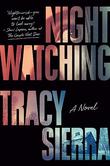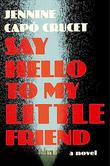
by Karen Kane & Jonaz McMillan ; illustrated by Dion MBD ‧ RELEASE DATE: tomorrow
A thrilling tale of bravery, friendship, and the power of signing.
Two friends use American Sign Language to ward off a monster.
After reading a frightening story, Milo worries that there’s a monster under his bed. Luckily, Milo’s best friend Mel’s bedroom window faces his, and both children use ASL to communicate. Mel helps Milo use “monster hands”—fingers spread and bent into claws—to cast shadows on the wall that will scare away anything lurking beneath the bed. With Mel’s help, Milo learns to be a little bit braver, but not at the expense of his gentle nature. Many of the signs that the characters use in the dialogue are captured in the illustrations; readers who don’t already sign will come away knowing the ASL signs for roar, chomp, laugh, and hug, each of which is clearly depicted. Children will eagerly sign or shout along with the most exciting moments. MBD uses color, light, and perspective to create cute yet dramatic illustrations. The shadowy monsters that Milo imagines are a bit creepy but never too terrifying. This is an excellent read for any child fretting about things that go bump in the night, as well as an effortless celebration of ASL. Milo has straight brown hair and light skin, while Mel has straight black hair and brown skin.
A thrilling tale of bravery, friendship, and the power of signing. (Picture book. 3-7)Pub Date: tomorrow
ISBN: 9780593532294
Page Count: 32
Publisher: Nancy Paulsen Books
Review Posted Online: Feb. 17, 2024
Kirkus Reviews Issue: March 15, 2024
Share your opinion of this book
More by Beth Bacon
BOOK REVIEW
by Beth Bacon & Karen Kane ; illustrated by Eric Barclay
BOOK REVIEW
by Karen Kane ; illustrated by Carlisle Robinson

by Sybil Rosen ; illustrated by Camille Garoche ‧ RELEASE DATE: March 16, 2021
Renata’s wren encounter proves magical, one most children could only wish to experience outside of this lovely story.
A home-renovation project is interrupted by a family of wrens, allowing a young girl an up-close glimpse of nature.
Renata and her father enjoy working on upgrading their bathroom, installing a clawfoot bathtub, and cutting a space for a new window. One warm night, after Papi leaves the window space open, two wrens begin making a nest in the bathroom. Rather than seeing it as an unfortunate delay of their project, Renata and Papi decide to let the avian carpenters continue their work. Renata witnesses the birth of four chicks as their rosy eggs split open “like coats that are suddenly too small.” Renata finds at a crucial moment that she can help the chicks learn to fly, even with the bittersweet knowledge that it will only hasten their exits from her life. Rosen uses lively language and well-chosen details to move the story of the baby birds forward. The text suggests the strong bond built by this Afro-Latinx father and daughter with their ongoing project without needing to point it out explicitly, a light touch in a picture book full of delicate, well-drawn moments and precise wording. Garoche’s drawings are impressively detailed, from the nest’s many small bits to the developing first feathers on the chicks and the wall smudges and exposed wiring of the renovation. (This book was reviewed digitally with 10-by-20-inch double-page spreads viewed at actual size.)
Renata’s wren encounter proves magical, one most children could only wish to experience outside of this lovely story. (Picture book. 3-7)Pub Date: March 16, 2021
ISBN: 978-0-593-12320-1
Page Count: 40
Publisher: Schwartz & Wade/Random
Review Posted Online: Jan. 12, 2021
Kirkus Reviews Issue: Feb. 1, 2021
Share your opinion of this book

by Tish Rabe ; illustrated by Laura Hughes ‧ RELEASE DATE: June 21, 2016
While this is a fairly bland treatment compared to Deborah Lee Rose and Carey Armstrong-Ellis’ The Twelve Days of...
Rabe follows a young girl through her first 12 days of kindergarten in this book based on the familiar Christmas carol.
The typical firsts of school are here: riding the bus, making friends, sliding on the playground slide, counting, sorting shapes, laughing at lunch, painting, singing, reading, running, jumping rope, and going on a field trip. While the days are given ordinal numbers, the song skips the cardinal numbers in the verses, and the rhythm is sometimes off: “On the second day of kindergarten / I thought it was so cool / making lots of friends / and riding the bus to my school!” The narrator is a white brunette who wears either a tunic or a dress each day, making her pretty easy to differentiate from her classmates, a nice mix in terms of race; two students even sport glasses. The children in the ink, paint, and collage digital spreads show a variety of emotions, but most are happy to be at school, and the surroundings will be familiar to those who have made an orientation visit to their own schools.
While this is a fairly bland treatment compared to Deborah Lee Rose and Carey Armstrong-Ellis’ The Twelve Days of Kindergarten (2003), it basically gets the job done. (Picture book. 4-7)Pub Date: June 21, 2016
ISBN: 978-0-06-234834-0
Page Count: 32
Publisher: Harper/HarperCollins
Review Posted Online: May 3, 2016
Kirkus Reviews Issue: June 1, 2016
Share your opinion of this book
More by Tish Rabe
BOOK REVIEW
by Tish Rabe ; illustrated by Sarah Jennings
BOOK REVIEW
by Tish Rabe ; illustrated by Dan Yaccarino
© Copyright 2024 Kirkus Media LLC. All Rights Reserved.
Hey there, book lover.
We’re glad you found a book that interests you!
We can’t wait for you to join Kirkus!
It’s free and takes less than 10 seconds!
Already have an account? Log in.
OR
Trouble signing in? Retrieve credentials.
Welcome Back!
OR
Trouble signing in? Retrieve credentials.
Don’t fret. We’ll find you.





